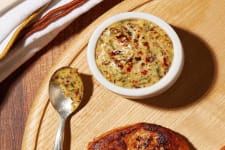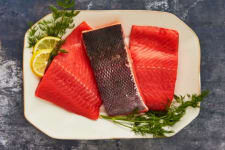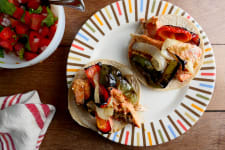When the schools of Homer, Alaska shut down in the midst of the 2020 Covid pandemic, Erik and Lacey Velsko brought their three children aboard their 58-foot fishing boat, the Kaia, and called it halibut homeschool. In addition to the one other deckhand aboard, the kids — aged 7, 9 and 11 at the time — worked the deck while learning the ins and outs of commercial halibut fishing. Now, four years later, the Velsko kids still frequently join their parents on board. Their oldest, now 15, even has a Bristol Bay salmon permit of her own, fishing the salmon run as a summer job.
Owning and operating three boats means the Velskos have to prioritize fishing over other things, like family vacations, and that’s a lesson the kids are learning. “It’s a little bit of a sacrifice for them to be gone,” Lacey says. “They don’t get to hang out with all their friends and do all the fun summer stuff, but at the end of the season when they get a paycheck, they're kind of like, shoot, that’s more money than I’d make working at a coffee shop all summer.”

The Velskos, both born and raised in Homer, Alaska, grew up in fishing families. Erik fished for halibut on his dad’s small boat before moving to Bristol Bay to fish for salmon and then paying for college by crab fishing on the Bering Sea. Lacey grew up aboard her family’s tender on Kachemak Bay. Tenders are boats onto which commercial fishing boats offload their catch. The tender transports the fish to the processing facility and also ferries supplies to the fishing boats, allowing them to stay on the water longer.
Throughout the year, the Velskos’ boats fish a variety of species from halibut to sablefish (also known as black cod) to different types of salmon and crab while also doing survey work for the International Pacific Halibut Commission. This survey work helps to inform the quotas set by the State of Alaska to ensure a sustainable harvest. They fish parts of Alaska ranging from Yakutat all the way to Dutch Harbor. For them, Homer is an ideal place to live, not only because it’s centrally located, but also because of its strong sense of community. Both Velskos actually went to high school in Homer with Wild Alaskan Company founder, Arron Kallenberg.
“Homer is kind of a small melting pot of people that fish all over the state,” Erik says. “Everyone knows everyone. Even if you're not in the same fishery, you have an idea of what guys are doing. And everyone helps each other out. People are always borrowing parts and pieces. A lot of times your schedules don't line up, but then sometimes they do, so you'll be in the harbor next to a guy that you haven't seen in a while. So that's kind of nice to see.”

There is no typical day in the life of the Velskos. Every day is different depending on the season. While longline fishing for halibut, though, the workday starts at sunrise and runs until 1 a.m. or so when all the day’s fish is cleaned and stored in ice in the boat’s hold, and the gear is baited up and ready for the next day’s work. Then there’s a few hours’ nap before the next day’s work starts. Fishing with pots for Pacific cod is a different beast. “It’s pretty nasty fishing,” Erik says, referring to the 20–22-hour days in icy wintertime conditions on the Bering Sea.
To anyone unfamiliar with what’s going on aboard the boat, the crew’s work looks backbreaking. But it’s what Erik refers to as an “industrial ballet.”
“You work with the roll of the boat and the movements of the boat,” he says. “If you use the rolls and pitches to your favor, things can get easier. When you watch a good crew work together, they don’t even really have to talk. Everyone knows what to do and everyone’s in the right place, and that’s what makes it kind of fun.”
Both Velskos feel an immense amount of pride in what they do, and they love the way the fishing life allows them a certain level of freedom.

“You decide your own fate to a certain extent,” Erik says. “…You're kind of your own boss, so you dictate what happens and when things occur. That's probably why most people are interested in fishing. It's a different lifestyle than a regular nine-to-five deal. You’re providing jobs for people and you’re providing food for people, so there’s a sense of pride in that.”
The whole business for the Velskos, though, boils down to family and to food. When asked to name a favorite recipe or meal, Lacey rattles off too many to name. They eat salmon, sablefish, halibut and crab multiple times per week. Sablefish chowder, though, might take the cake.
“All this fish we catch is not just to make a paycheck,” Erik says. “It’s what people eat. I think that’s important to have in everyone’s mind while they’re harvesting: this is someone’s food at the end of the day, and you need to treat it that way.”






